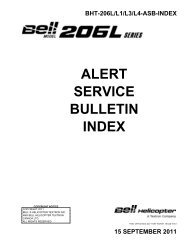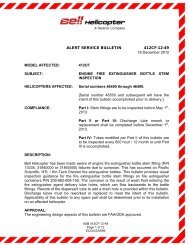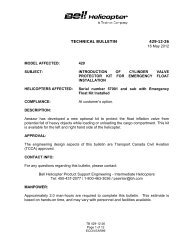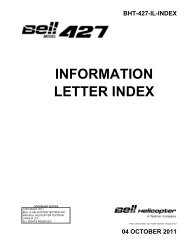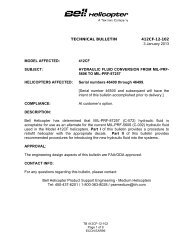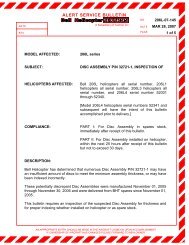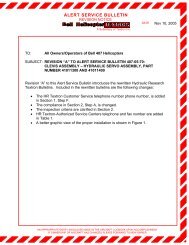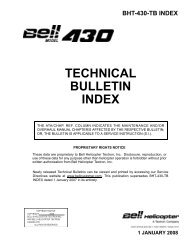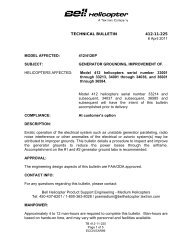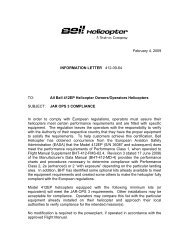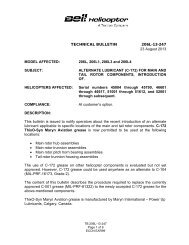407 SUBJECT - BellCustomer.com
407 SUBJECT - BellCustomer.com
407 SUBJECT - BellCustomer.com
Create successful ePaper yourself
Turn your PDF publications into a flip-book with our unique Google optimized e-Paper software.
TECHNICAL BULLETIN <strong>407</strong>-11-94<br />
18 October 2011<br />
MODEL AFFECTED: <strong>407</strong><br />
<strong>SUBJECT</strong>: LITTER DOOR SEAL IMPROVEMENT,<br />
INSTALLATION OF.<br />
HELICOPTERS AFFECTED: Serial number 53000 through 54061.<br />
[Serial number 54062 and subsequent will have the<br />
intent of this Bulletin ac<strong>com</strong>plished prior to delivery.]<br />
COMPLIANCE:<br />
At Customer’s Option.<br />
Several operators have reported that the existing litter door seal installation is<br />
inadequate and allows water to leak inside the cabin both statically and in flight. A<br />
redesigned litter door seal in <strong>com</strong>bination with a new contour seal installation has been<br />
developed to eliminate water ingress.<br />
If the helicopter is equipped with Aeronautical Accessories (AA) high visibility crew<br />
doors STC# SR09376RC-D, <strong>com</strong>pliance with this Technical Bulletin could render the<br />
crew doors harder to close depending on door shimming and adjustment. Contact AA<br />
for assistance.<br />
If the helicopter is equipped with Aeronautical Accessories (AA) aft passenger sliding<br />
doors STC# SR01040AT, this Technical Bulletin is <strong>com</strong>patible; however, some minor<br />
changes to the original installation may be required. Contact AA for assistance.<br />
APPROVAL:<br />
The engineering design aspects of this Bulletin are Transport Canada Civil Aviation<br />
(TCCA) approved.<br />
CONTACT INFO:<br />
For any questions regarding this Bulletin, please contact:<br />
Bell Helicopter Product Support Engineering - Light Helicopters<br />
Tel: 450-437-2862 / 1-800-363-8023 / pselight@bellhelicopter.textron.<strong>com</strong><br />
TB <strong>407</strong>-11-94<br />
Page 1 of 20<br />
ECCN EAR99
MANPOWER:<br />
Approximately 10 man-hours are required to <strong>com</strong>plete this Bulletin. This estimate is<br />
based on hands-on time, and may vary with personnel and facilities available.<br />
Taking into consideration adhesive cure times at ambient temperatures, approximately<br />
24 hours are required to <strong>com</strong>plete this Bulletin.<br />
WARRANTY:<br />
There is no warranty credit applicable for parts or labor associated with this Bulletin.<br />
MATERIAL:<br />
Required Material:<br />
The following material is required for the ac<strong>com</strong>plishment of this Bulletin and may be<br />
obtained through your Bell Helicopter Textron Supply Center.<br />
Part Number Nomenclature Qty<br />
<strong>407</strong>-030-657-103 Litter door seal 1<br />
120-285-1 Seal 70<br />
120-210-008G048 Shim peelable (1) 1<br />
(1) Shim required only if proper door adjustment may not be obtained during litter<br />
door seal installation.<br />
Consumable Material:<br />
The following material is required to ac<strong>com</strong>plish this Bulletin, but may not require<br />
ordering, depending on the operator’s consumable material stock levels. This material<br />
may be obtained through your Bell Helicopter Textron Supply Center.<br />
Part Number Nomenclature Qty Reference *<br />
MIL-PRF-81733 TYII Sealant 1 C-251<br />
299-947-152TICL1 1OZ Adhesive (Dapcotac 3300) 5 C-300<br />
299-947-152,TY1,CL2 Adhesive (RTV 732) 1 C-307<br />
Acetone Solvent A/R C-316<br />
80 Grit Abrasive paper A/R Commercial<br />
Abrasive pad Abrasive pad A/R C-<strong>407</strong><br />
* C-XXX numbers refer to the consumables list in BHT-ALL-SPM Standard Practices Manual<br />
SPECIAL TOOLS:<br />
None required<br />
TB <strong>407</strong>-11-94<br />
Page 2 of 20<br />
ECCN EAR99
WEIGHT AND BALANCE:<br />
Not affected<br />
ELECTRICAL LOAD DATA:<br />
Not affected<br />
REFERENCES:<br />
BHT-<strong>407</strong>-IPB Illustrated Parts Breakdown<br />
BHT-<strong>407</strong>-MM Maintenance Manual<br />
TB <strong>407</strong>-98-11 Litter Door Seal, Modification of<br />
PUBLICATIONS AFFECTED:<br />
BHT-<strong>407</strong>-IPB Illustrated Parts Breakdown<br />
BHT-<strong>407</strong>-MM Maintenance Manual<br />
ACCOMPLISHMENT INSTRUCTIONS:<br />
-NOTE-<br />
For helicopter serial number 53000 through 53169 which<br />
have not <strong>com</strong>plied with TB <strong>407</strong>-98-11, it is important to<br />
<strong>com</strong>ply with the following portion. Modify the top litter door<br />
closeout and install the bottom door pad per TB <strong>407</strong>-98-11<br />
prior to ac<strong>com</strong>plishment of this Bulletin.<br />
-NOTE-<br />
This installation requires that the door latches are properly<br />
adjusted and that the door hinges have no excessive<br />
looseness. Refer to BHT-<strong>407</strong>-MM Chapter 52.<br />
1. Prepare helicopter for maintenance.<br />
a. Prepare a clean work surface for the modification of the litter door.<br />
b. Separate L/H aft passenger door (1, Figure 1) from the litter door (2) and put<br />
aside. Remove litter door (2) from the helicopter. Refer to BHT-<strong>407</strong>-MM Chapter<br />
52.<br />
c. Remove interior plastic trim panel of the litter door (2). Refer to BHT-<strong>407</strong>-IPB<br />
Illustrated Parts Breakdown Chapter 25 to view mounting hardware.<br />
TB <strong>407</strong>-11-94<br />
Page 3 of 20<br />
ECCN EAR99
2. Remove seals and prepare surfaces as follows:<br />
a. Remove existing seal (2, Figure 2, Sheet 1) from the litter door (1) and on the<br />
airframe’s side body door frame contour (4). Do not discard removed seals at this<br />
time.<br />
b. Remove existing litter door T-seal (3) and discard.<br />
c. Remove residual adhesive and/or double sided tape from litter door (1) and side<br />
body door frame contour (4) with Acetone (C-316), aided with a plastic scraper or<br />
abrasive pad (C-<strong>407</strong>). Dry up surfaces with a clean dry cloth.<br />
3. Prepare the installation of the new litter door seal (6, Figure 2, Sheet 2) as follows:<br />
a. Prior to bonding seal (6) into position a litter door (1) adjustment check is<br />
required. Temporarily position litter door (1) in its location onto the airframe<br />
hinges.<br />
-NOTE-<br />
The next Steps to adjust the gap are critical. The position of<br />
the door in relation to the frame will locate the litter door seal<br />
(6) in its appropriate place for proper mating with the new<br />
door frame contour seal (5) to be installed in a later Step.<br />
b. Close the litter door (1) and latch. Pull the door outboard against the top and<br />
bottom latched pins. Locate a feeler gauge 2 inches (5 cm) from the top aft end<br />
corner of the litter door (1) and measure the gap as shown in Figure 3. The<br />
optimal gap to obtain for proper sealing is 0.285 in +/- .005 (7.2 mm +/- 1.3).<br />
(1) If the measured gap is smaller than the optimal gap, the top litter door striker<br />
pin housing needs to have shims removed to push the door away from the<br />
airframe sidebody. To adjust the litter door, refer to BHT-<strong>407</strong>-MM Chapter 52.<br />
In conjunction with the adjustment verify that the door flushness remains<br />
visually tolerable as shown in Figure 3.<br />
(2) If the measured gap is greater than the optimal gap, the top litter door striker<br />
pin housing needs to have shims added to pull the door closer to the airframe<br />
sidebody. To adjust the litter door, refer to BHT-<strong>407</strong>-MM Chapter 52. In<br />
conjunction with the adjustment verify that the door flushness remains visually<br />
tolerable as shown in Figure 3.<br />
(3) If the appropriate gap is obtainable, go to Step 4. If the specific gap range<br />
cannot be obtained with the door adjustments; then shimming the litter door<br />
seal P/N <strong>407</strong>-030-657-103 into position is required. Double check your<br />
readings and adjustments, if the gap is confirmed to wide, go to next Step c.<br />
TB <strong>407</strong>-11-94<br />
Page 4 of 20<br />
ECCN EAR99
c. To calculate the required shim thickness, take the measured gap and subtract<br />
the optimal desired gap; the resultant will be the required shim thickness. As an<br />
example, if the gap measured was 0.310 in (7.87 mm) minus the optimal gap of<br />
0.285 in (7.24 mm) the resultant required shim thickness of 0.025 in (0.63 mm) is<br />
required. Lightly heat the shim laminate P/N 120-210-008G048 with a heat gun to<br />
aid splitting to the desired established shim thickness required.<br />
d. Refer to Figure 4, mark and cut the shim’s protruding end flush with the seal.<br />
Utilize the rectangular piece that was cut, to fill the remainder of the gap on the<br />
aft top corner of the litter door. Sand a radius on the full length of the shim to<br />
match the radius contour of the door. Trim any excess side material that could<br />
interfere with the litter door seal installation.<br />
e. Wipe faying surfaces with Acetone (C-316) and bond the shim into position with<br />
sealant (C-251). Remove and fair excess sealant. Do not bond litter door seal at<br />
this time, Go to Step 4.<br />
4. Install seal (5, Figure 2, Sheet 2) onto the L/H passenger door frame contour (4) as<br />
follows:<br />
a. Utilize the seal that was safeguarded in the first Steps. Cut the new seal (5) to<br />
the appropriate length plus an additional 4 inches (101.6 mm) of extra material to<br />
work with during installation.<br />
-NOTE-<br />
To ensure proper bonding of seal (5) to airframe, in the<br />
following steps, it is imperative that no white talcum powder<br />
residue is left on the seal surface prior to adhesive<br />
application. Wipe and clean seal surface meticulously.<br />
b. Select the side of the seal with the part number markings as the surface to be<br />
bonded down. Roughen faying surface of seal (5) with 80 grit abrasive paper to<br />
ensure adherence. Wipe faying surface of the seal (5) and side body frame<br />
contour (4) with Acetone (C-316). Wipe surface dry with a clean dry cloth.<br />
c. Coat faying surfaces of the seal (5) and the edge of the door opening (4) with a<br />
generous layer of adhesive (C-300). Allow 15-20 minutes for adhesive to set<br />
before joining the two surfaces.<br />
-NOTE-<br />
Once dry, the adhesive (C-300) layers are ready for a one<br />
time installation. Once the two faying surfaces have made<br />
hard contact the seal cannot be pulled off and repositioned.<br />
TB <strong>407</strong>-11-94<br />
Page 5 of 20<br />
ECCN EAR99
If the seal is pulled the adhesive needs reapplication in that<br />
specific area.<br />
d. Start the installation of the seal (5) 2 inches (5 cm) aft of the lower forward corner<br />
of the door opening (Figure 2, Sheet 2, Detail A). Make sure that seal (5) points<br />
to the inside of the door opening. Install the seal (5) aft along the edge keeping<br />
flush with the door opening and up flat against the interior bend radius of the side<br />
body fairing. Join the extremities to match the ends of the seal (5). Refer to BHT-<br />
<strong>407</strong>-MM Chapter 52.<br />
5. Install litter door seal (6, Figure 2, Sheet 2 & 3) and seal (5) as follows:<br />
a. Roughen faying surface of seals with 80 grit abrasive paper to ensure<br />
adherence. Wipe faying surface of the seal with Acetone (C-316). Wipe surface<br />
dry with a clean dry cloth.<br />
b. Prepare the litter door (1). Wipe faying surfaces of the door with Acetone (C-<br />
316). Wipe surface dry with a clean dry cloth.<br />
c. Coat faying surfaces of the seal (6) and the door faying surfaces with a generous<br />
layer of adhesive (C-300). Allow 15-20 minutes for adhesive to set before joining<br />
the two surfaces.<br />
-NOTE-<br />
Once dry, the adhesive (C-300) layers are ready for a one<br />
time installation. Once the two faying surfaces have made<br />
hard contact, the seal cannot be pulled off and repositioned<br />
unless adhesive is reapplied in that specific area.<br />
d. Start the installation of the seal (6) at the top aft corner of the litter door (1). This<br />
portion of the seal (6) is called the “T-seal” and is awkward to install since there<br />
are three faces to match fit in the appropriate location in one movement. Keep<br />
the top surface flush with the door edge and continue on positioning the seal<br />
down to the bottom forward corner as shown on Figure 5, Sheet 1. When<br />
bonding over the door hinge radius blocks, it is possible that the seal (6) does not<br />
touch the most forward extremities of the radius blocks. If a gap is apparent, the<br />
void is to be filled with sealant (C-251).<br />
CAUTION<br />
Do not cut the extremity flush, the overhang is required<br />
further on.<br />
e. From the bottom forward corner gradually transition the reference line from the<br />
outside edge of door to interior door frame bend radius. Butt up edge of seal (6)<br />
TB <strong>407</strong>-11-94<br />
Page 6 of 20<br />
ECCN EAR99
flat against bend radius and bond remainder of the seal (6) as shown on Figure<br />
5, Sheet 1.<br />
f. Cut 4 feet of seal (5) to install on the litter door (1). Position the seal (5) making<br />
sure it points aft or away from the door. Select the side of the seal (5) with the<br />
part number markings as the faying surface to be joined. Cut at an angle and trim<br />
to match fit with the bottom side of the T-seal installed in the previous Step as<br />
shown on Figure 5, Sheet 1. Roughen faying surface of the seal (5) with 80 grit<br />
abrasive paper to ensure adherence. Wipe faying surface of the seal and faying<br />
surface of the litter door with Acetone (C-316). Wipe surface dry with a clean dry<br />
cloth.<br />
-NOTE-<br />
To ensure proper bonding of seal (5) to airframe, in the<br />
following steps, it is imperative that no white talcum powder<br />
residue is left on the seal surface prior to adhesive<br />
application. Wipe and clean seal surface meticulously.<br />
g. Coat faying surfaces of the seal (5) and the door faying surfaces with a generous<br />
layer of adhesive (C-300). Allow 15-20 minutes for adhesive to set before joining<br />
the two surfaces.<br />
-NOTE-<br />
Once dry, the adhesive (C-300) layers are ready for a one<br />
time installation. Once the two faying surfaces have made<br />
hard contact, the seal cannot be pulled off and repositioned<br />
unless adhesive is reapplied in that specific area.<br />
CAUTION<br />
Do not cut the seal (5) extremity flush, the overhang is<br />
required in the next Step.<br />
h. Start the installation of the seal (5) at the top aft corner below the “T-seal”. Bond<br />
the faying surfaces along the edge of the door. Maintain flush with the door<br />
opening and up flat against the interior bend radius of the door.<br />
i. Refer to Figure 5, Sheet 1 & 2. Join the seal P/N 120-285-1 (5) with seal P/N<br />
<strong>407</strong>-030-657-103 (6) as follows:<br />
TB <strong>407</strong>-11-94<br />
Page 7 of 20<br />
ECCN EAR99
CAUTION<br />
If the next steps are not followed precisely as depicted in the<br />
Figures the door will bind on the seal when closing<br />
(1) Cut out center web of seal (5) as shown. Cut seal (1) length to match fit into<br />
the interior of portion of seal (5).<br />
(2) Roughen seal faying surfaces with 80 grit abrasive paper to ensure<br />
adherence. Wipe faying surface of the seals faying surface with Acetone (C-<br />
316). Wipe surface dry with a clean dry cloth.<br />
(3) Coat faying surfaces of the seals with a generous layer of adhesive (C-300).<br />
Allow 15-20 minutes for adhesive to set before joining the two surfaces.<br />
(4) Bond seals together, cut seal to the appropriate angles as shown in Figure 5,<br />
Sheet 2. Wipe surface clean with Acetone (C-316) and apply sealant (C-251)<br />
to seal gap between the door and the mating corner of the two seals. Refer to<br />
Figure 2 (Sheet 3), Detail C.<br />
j. Temporarily install litter door and L/H passenger door on aircraft. Latch litter door<br />
into position and slowly close the L/H passenger door. Refer to Figure 6 (Sheet 1<br />
& 2) and confirm the following:<br />
(1) The “T-seal” (6) correctly matches with seal (5) with side body door frame.<br />
(2) The passenger door corner properly slides into the “T-seal” cavity. If required,<br />
trim the top of seal (5) to avoid contact with the outer lip of the “T-seal”. Trim<br />
as required any portion of the seal (5) that may cause binding when closing<br />
the L/H passenger door.<br />
(3) The bottom corner closes properly. No binding.<br />
k. Once proper closing is confirmed, apply a thick bead of adhesive silicone (C-307)<br />
onto the back side of the “T-seal”. Refer to Figure 2, Sheet 3.<br />
l. At the butt line of seal P/N 120-285-1 (5) and “T-seal” (6), apply as shown Figure<br />
2, Sheet 2, adhesive (C-307) to lightly fill any gap at tip of the seal (5) to create a<br />
joint. During the cure time period, temporarily install a piece of anti-adhesion tape<br />
on the interior surface of the L/H passenger door to allow closing.<br />
m. Gently close the litter door and lock into position. Gently close the L/H passenger<br />
door and latch into position. Wipe surface clean with Acetone (C-316) and apply<br />
a bead of sealant (C-251) on the exterior lip of the “T-seal” and litter door as<br />
shown in Figure 6, Sheet 2.<br />
TB <strong>407</strong>-11-94<br />
Page 8 of 20<br />
ECCN EAR99
n. Leave the doors closed in this position for 8 hours while adhesive and sealant is<br />
curing.<br />
6. Install seal P/N 120-285-1 (5) onto the side body door frame contour of the<br />
remaining three doors as follows:<br />
a. Repeat Step 4 for the crew doors, except the start line for the seals is<br />
approximately 2 inches (50 mm) forward of the lower aft corner of the door<br />
opening. Refer to BHT-<strong>407</strong>-MM Chapter 52<br />
7. Adjust all doors and leak check installation as follows:<br />
a. The new seal P/N 120-285-1 (5) installed is stiffer than the previous design.<br />
Adjust the passenger and crew door striker pins as required. Refer to BHT-<strong>407</strong>-<br />
MM Chapter 52. With the new seals installed, it is <strong>com</strong>mon to adjust the striker<br />
pins outboard. If the aircraft is equipped with automatic door openers, it is<br />
imperative to have them installed when conducting any adjustments to the striker<br />
pins.<br />
b. In the event that the L/H passenger door is remaining difficult to close, review<br />
possible causes listed in Step 5, j. Additionally, from inside the cabin, visually<br />
verify that the top forward section of the trim panel on the L/H passenger door is<br />
not causing a binding effect between the door frame and the “T-seal”. If the trim<br />
is found to interfere while closing the L/H passenger door, it is acceptable to cut<br />
out only the portion of trim that firmly contacts the new “T-seal” installation.<br />
c. If the door edge catches on the “T-seal” while closing, it is acceptable to sand a<br />
radius on the door corner as described in Technical Bulletin <strong>407</strong>-98-11, Figure 1,<br />
Detail D.<br />
d. Ac<strong>com</strong>plish water leak check as follows:<br />
(1) Place an observer in the cabin with a flashlight to look for water infiltrations.<br />
(2) Close all windows. Close and latch all doors.<br />
(3) Using a garden hose with tap water, at a distance of 4 to 6 feet away, spray<br />
down and aft with a medium to dense spray pattern about the walkway<br />
including top of door.<br />
(4) Continue to spray water for 5 minutes.<br />
(5) As an alternate means to check for leaks, slowly pour 5 liters of water over<br />
the door’s sealing areas.<br />
8. In case a leak is detected, remedy as follows:<br />
TB <strong>407</strong>-11-94<br />
Page 9 of 20<br />
ECCN EAR99
a. Verify that door latches are adjusted properly and that hinges do not have<br />
excessive looseness.<br />
b. Verify the bond line between the seals and the frames are proper. In the event<br />
that the seal was pulled off slightly and repositioned during installation, the<br />
affected area will need reapplication of adhesive (C-300).<br />
c. Verify seal surfaces for cleanliness and condition.<br />
-NOTE-<br />
Always sand longitudinally to the direction of the seal<br />
d. Verify the door mating surface with seal. Clean the contact area if found dirty.<br />
Examine surface for scratches, grooves or discontinuities that may provide a<br />
pathway for the water ingress. Lightly sand to provide a smooth surface or fill and<br />
fair as required..<br />
e. Repair or replace any of the above items as required. Repeat leak check until<br />
satisfactory.<br />
f. In the event that leaks are still apparent, call Product Support Engineering for<br />
assistance. Refer to the cover page to obtain our contact information.<br />
9. Return aircraft to service; properly reinstall trims, doors, and other items removed for<br />
the ac<strong>com</strong>plishment of this Bulletin.<br />
-NOTE-<br />
Seal P/N 120-285-1 installed onto the side body door frame<br />
contour is stiffer and sticks out more than the original seal<br />
removed. This difference makes it easier for the feet to snag<br />
and debond the seal during frequent cabin boarding. At<br />
customers option it is acceptable to apply a bead of<br />
adhesive silicone (C-307) along the edge between the seal<br />
and the frame to provide additional bond line strength.<br />
TB <strong>407</strong>-11-94<br />
Page 10 of 20<br />
ECCN EAR99
10. Make an entry in helicopter historical service records indicating <strong>com</strong>pliance with this<br />
Technical Bulletin.<br />
Figure 1.Seal Installation overview<br />
TB <strong>407</strong>-11-94<br />
Page 11 of 20<br />
ECCN EAR99
Figure 2. Door seal installation (Sheet 1 of 3)<br />
TB <strong>407</strong>-11-94<br />
Page 12 of 20<br />
ECCN EAR99
Figure 2. Door seal installation (Sheet 2 of 3)<br />
TB <strong>407</strong>-11-94<br />
Page 13 of 20<br />
ECCN EAR99
Figure 2. Door seal installation (Sheet 3 of 3)<br />
TB <strong>407</strong>-11-94<br />
Page 14 of 20<br />
ECCN EAR99
Figure 3. Litter door adjustment (If required)<br />
TB <strong>407</strong>-11-94<br />
Page 15 of 20<br />
ECCN EAR99
Figure 4. Shim installation (If required)<br />
TB <strong>407</strong>-11-94<br />
Page 16 of 20<br />
ECCN EAR99
“T-Seal’<br />
Lower Door hinge<br />
radius block.<br />
Transition from the<br />
outside to the inside.<br />
“T-seal” lower<br />
corner<br />
Litter Door<br />
lower corner<br />
1<br />
2<br />
Cut to Match Fit<br />
seal 120-285-1<br />
Cut the two seals at the junction as<br />
shown. Cut out center web of seal<br />
P/N 120-285-1 up 2 inches.<br />
Figure 5. Installation of litter door seals (Sheet 1 of 2)<br />
TB <strong>407</strong>-11-94<br />
Page 17 of 20<br />
ECCN EAR99
Bond the two seals<br />
together<br />
View from top pushing down on seal<br />
Refer to Figure 2 Detail C<br />
to view the appropriate<br />
cut angles required.<br />
Figure 5. Installation of litter door seals (Sheet 2)<br />
TB <strong>407</strong>-11-94<br />
Page 18 of 20<br />
ECCN EAR99
Step J, (1) Confirm seals<br />
correctly match<br />
Step L, Apply adhesive (C-307)<br />
View of the “T-Seal” from inside the cabin.<br />
Step J, (2) Confirm door fit<br />
Step J, Minor trimming of seal<br />
edge as required.<br />
Figure 6. Installation of the litter door and passenger door (Sheet 1 of 2)<br />
TB <strong>407</strong>-11-94<br />
Page 19 of 20<br />
ECCN EAR99
Litter and Passenger<br />
bottom door corner.<br />
Step J, (3) no binding<br />
at bottom corner.<br />
Step M Apply a bead of<br />
sealant (C-251).<br />
Figure 6. Installation of the litter door and passenger door (Sheet 2)<br />
TB <strong>407</strong>-11-94<br />
Page 20 of 20<br />
ECCN EAR99



